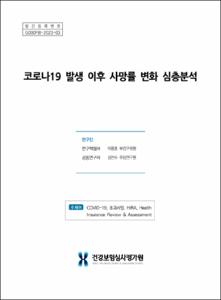코로나19 발생 이후 사망률 변화 심층분석
- Type
- Research report
- Issued Date
- 2023-01
- Abstract
- Since the first case of COVID-19 infection in South Korea in January 2020, through multiple waves of infection, there have been a total of 27,098,566 confirmed cases and 30,506 deaths as of November 2022. In this regard, Health Insurance Review & Assessment Service conducted a study on the occurrence of excess deaths during the pandemic(2020) to the point in time the study was carried out to analyze the excess deaths from all causes of death. This study, therefore, investigated excess deaths per cause-of-death by including data from 2021, when the COVID-19 pandemic became widespread in the country.
Using the statistics Korea’s cause-of-deaths statistics data for 2010-2020, the predicted number of deaths for 2021 was calculated and compared with the actual number of deaths for the year. Factors like the season, abnormal weather, and year were identified and explanatory variables when calculating the predicted number of deaths. Resident registration data was applied as the adjustment variable to set up a negative-binomial model, and in-depth analysis was performed for gender, age, and region according to the causes of excess deaths.
According to analysis, the number of deaths caused by all causes in 2021 is 317,68, which is 4,168 more than the predicted number of 313,512 deaths. Excluding items with a small number of death samples(such as injury, poisoning, and certain other outcomes due to external causes) to confirm excess mortality by specific causes, the following five causes of death where excess deaths occurred were confirmed from the analysis of 12 causes of death: “certain infectious and parasitic diseases (A00-B99, U07.1, U07.2)”, “endocrine, nutritional, and metabolic diseases (E00-E88)”, “diseases of the digestive system (K00-K92)”, “diseases of the musculoskeletal system and connective tissue (M00-M99)”, and “symptoms, signs, and abnormal clinical and laboratory findings, not elsewhere classified (R00-R99)”. For the three causes of death of “mental and behavioral disorders (F01-F99)”, “diseases of the nervous system (G00-G98)”, and “diseases of the respiratory system (J00-J98, U04)”, the actual numbers of deaths were fewer than the predicted number. Furthermore, among the four causes of deaths of “neoplasms (C00-D48)”, “diseases of the circulatory system (I00-I99)”, diseases of the genitourinary system (N00-N99)“, and ”external causes of morbidity and mortality (V01-Y98)“, there was no statistically significant excess deaths.
Excess deaths is an important indicator for understanding the impact of infectious diseases and accidents. Whether excess deaths has occurred is determined according to the predicted number of deaths, so it is necessary to develop a clear and widely accepted prediction method through expert consensus. The development of a consensus model for determining excess deaths, and the integration of key data from various organizations can help assess the impact of COVID-19 on the healthcare sector, which information can be used as basic data for preparing measures in the event similar infectious diseases emerge in the future.
- Publisher
- 건강보험심사평가원
- Alternative Title
- In-depth analysis of changes in mortality since the outbreak of COVID-19
- Table Of Contents
- 제1장 서론 ······································································ 1
1. 연구 배경 ······························································································ 1
2. 연구 목적 ······························································································ 3
제2장 초과사망 개념 및 연구 동향 ······································································ 7
1. 초과사망 개념 ························································································ 7
2. 국내․외 연구동향 ·················································································· 11
3. 소결 ···································································································· 13
제3장 연구방법 ······································································ 17
1. 자료원 ································································································· 17
2. 분석방법 ······························································································ 17
가. 분석 모델 ································································································ 17
나. 변수 선정 ································································································ 18
제4장 연구결과 ······································································ 25
1. 모든 원인(All-Cause) ··········································································· 25
2. 세부원인별 초과사망 ············································································· 26
가. 특정 감염병 및 기생충성 질환(A00-B99, U07.1, U07.2) ··························· 27
나. 신생물(C00-D48) ···················································································· 37
다. 내분비, 영양 및 대사 질환(E00-E88) ························································ 38
라. 정신 및 행동장애(F01-F99) ······································································ 46
마. 신경계통의 질환(G00-G98) ······································································· 47
바. 순환계통의 질환(I00-I99) ·········································································· 48
사. 호흡계통의 질환(J00-J98, U04) ······························································· 49
아. 소화계통의 질환(K00-K92) ······································································· 50
자. 근골격계통 및 결합 조직의 질환(M00-M99) ·············································· 58
차. 비뇨생식계통의 질환(N00-N98) ································································· 66
카. 달리 분류되지 않은 증상, 징후(R00-R99) ·················································· 67
타. 질병이환 및 사망의 원인(V01-Y89) ··························································· 76
제5장 결론 ······································································ 79
1. 고찰 ···································································································· 79
2. 결론 ···································································································· 80
◾ 참고 문헌 ······················································································· 83
◾ ABSTRACT ··················································································· 85
- Publisher
- 건강보험심사평가원
- Location
- KOR
- Citation
- 이풍훈. (2023-01). 코로나19 발생 이후 사망률 변화 심층분석.
- 파일 목록
-
-
Download
 코로나19 발생 이후 사망률 변화 심층분석 연구.pdf
기타 데이터 / 5.48 MB / Adobe PDF
코로나19 발생 이후 사망률 변화 심층분석 연구.pdf
기타 데이터 / 5.48 MB / Adobe PDF
-
Items in Repository are protected by copyright, with all rights reserved, unless otherwise indicated.